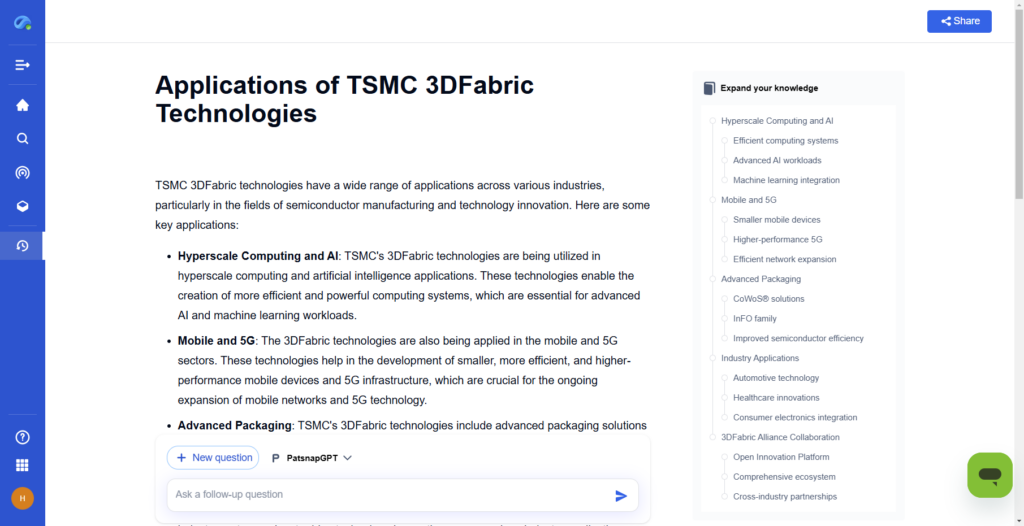
As semiconductor technology continues to advance, TSMC’s 3DFabric technologies stand at the forefront of innovation. These hybrid semiconductor solutions combine multiple cutting-edge processes, offering breakthrough performance, energy efficiency, and compact designs. In this article, we’ll analyze the latest technical developments behind TSMC’s 3DFabric, discuss their impact on various industries, and explore how tools like Eureka Seek provide real-time access to the most current research, patents, and competitive insights driving the semiconductor industry forward.

Understanding TSMC 3DFabric Technologies
TSMC’s 3DFabric is a cutting-edge portfolio that incorporates advanced manufacturing technologies into a unified platform. By integrating multiple semiconductor processes, TSMC has revolutionized the industry, addressing the need for smaller, more efficient, and powerful devices. Let’s dive into the latest technical components of TSMC’s 3DFabric technologies:
- CoWoS (Chip-on-Wafer-on-Substrate): By stacking multiple chips together, CoWoS enhances data throughput and power efficiency. This latest iteration has optimized signal integrity and thermal management, pushing the boundaries of high-performance computing applications.
- InFO (Integrated Fan-Out): InFO’s recent technological updates have improved cost/performance ratios for high-density mobile and network applications. The fan-out method offers improved interconnectivity and reduced power consumption, providing a competitive edge in modern electronics.
- TSMC-SoIC® (System on Integrated Chips): TSMC’s SoIC technology integrates chiplets into a single system, enabling advanced stacking techniques that improve power saving and reduce the form factor. The latest SoIC developments provide significant improvements in data transfer speed, making it a go-to solution for both consumer electronics and industrial sectors.
Each of these innovations serves as a testament to TSMC’s commitment to integrating the latest technological advancements in semiconductor manufacturing.
The Science Behind 3DFabric Technologies
3D Silicon Stacking and Advanced Packaging
3DFabric encompasses a range of technologies that enable the stacking of silicon chips in three dimensions, which is crucial for increasing the density and performance of semiconductor devices. This includes both front-end and back-end processes, such as TSMC-SoIC (System on Integrated Chips), CoWoS (Chip on Wafer on Substrate), and InFO (Integrated Fan-Out) technologies.
System Integration and Performance Enhancement
3DFabric allows for the integration of various chip components, including logic dies, high-bandwidth memory, and heterogeneous chiplets like analog and RF blocks. This holistic approach to system design enhances performance, power efficiency, and reduces form factor while accelerating time-to-market.
Innovative Interconnect Technologies
TSMC’s 3DFabric employs advanced interconnect technologies such as Through-Silicon Vias (TSVs), EMIB (Embedded Multi-Die Interconnect Bridge), and Foveros, which facilitate efficient communication between stacked chips. These technologies enable higher bandwidth and lower latency compared to traditional 2D packaging.
Material and Process Innovations
TSMC is investing in research and development of new materials, such as carbon nanotubes, and nanosheet technologies, to further advance 3D packaging. These innovations aim to improve the performance and efficiency of 3D ICs by scaling down channel thickness and enhancing thermal management.
Scalability and Flexibility
3DFabric offers a modular approach, allowing customers to reuse and scale technology blocks across different product lines. This flexibility is crucial for meeting the diverse needs of the semiconductor industry, from high-performance computing to mobile devices.
Ecosystem and Collaboration
TSMC collaborates with other technology providers, such as Cadence, to develop and optimize tools and platforms for 3D IC design and implementation. This ecosystem approach ensures that 3DFabric remains at the forefront of semiconductor technology innovation.
Performance Comparison: 3DFabric vs. Traditional Semiconductor Technologies
| Feature | Traditional Semiconductor Technologies | TSMC 3DFabric Technologies |
|---|---|---|
| Performance | Moderate, scaling issues hinder progress | Cutting-edge performance, chip stacking boosts throughput 🚀 |
| Power Efficiency | Average, dependent on older methods | Advanced power-saving design, reduces energy consumption 🔋 |
| Design Flexibility | Limited options for miniaturization | High flexibility with compact and multi-layered designs 📏 |
| Heat Management | Standard cooling techniques | Advanced thermal management through stacking 🌡️ |
| Best Use Case | General applications | High-performance computing, mobile devices, consumer electronics 💻 |
TSMC’s 3DFabric technologies outperform traditional methods in performance, power efficiency, and design flexibility, addressing the most demanding needs of modern industries.
Applications of TSMC 3DFabric Technologies

The technical advancements in TSMC’s 3DFabric are being implemented across several key industries.
- High-Performance Computing (HPC) and Artificial Intelligence (AI): TSMC’s 3DFabric technologies significantly enhance HPC and AI applications. By stacking silicon chips vertically, they boost computational power and efficiency. This innovation is crucial for training large AI models and performing complex computations faster.
- Hyperscale Computing: These technologies also benefit hyperscale computing. They enable the creation of more powerful, energy-efficient data centers, which are essential for managing vast amounts of data. This helps support the growing demand for online services.
- Mobile and 5G Applications: TSMC’s 3DFabric technologies extend beyond high-end uses. They also improve mobile devices and 5G networks by offering compact, efficient packaging. This leads to smaller, more powerful mobile devices and better 5G performance.
- General Industry Applications: The 3DFabric Alliance, a collaborative effort by TSMC, accelerates innovation in 3D IC technology. It aims to build an ecosystem that supports diverse industry applications and drives further advancements.
| Product/Project | Technical Outcomes | Application Scenarios |
|---|---|---|
| 3DFabric Technologies TSMC | Enable advanced packaging solutions like CoWoS and InFO for better integration and connectivity of components on a single chip. | Hyperscale computing, AI, mobile and 5G applications requiring high performance and efficiency. |
| 3DFabric Alliance Ecosystem TSMC | Collaborative effort with industry partners to drive technology innovation across various sectors using 3D IC technology. | Automotive, IoT, consumer electronics, and other industry applications benefiting from advanced packaging solutions. |
Challenges and Limitations of TSMC 3DFabric Technologies
Despite their advanced capabilities, there are challenges that come with TSMC 3DFabric technologies:
- High Initial Cost: The sophisticated manufacturing processes behind 3DFabric technologies involve higher costs compared to traditional methods. 💰
- Complex Manufacturing: With the integration of multiple processes into one system, the complexity of manufacturing increases, requiring specialized equipment and expertise. ⚙️
- Maintenance: The intricate nature of these technologies may require more frequent maintenance and updates to ensure optimal performance. 🛠️
However, the long-term benefits of superior performance, power efficiency, and design flexibility far outweigh the initial costs and complexities.
How Eureka Seek Accelerates Your Access to TSMC 3DFabric Innovations

To stay on top of the latest developments in semiconductor manufacturing, professionals need real-time access to the most current research and patents. Eureka Seek, an AI-powered innovation intelligence tool, offers unparalleled access to the latest advancements in TSMC 3DFabric technologies.
Key Features of Eureka Seek:
- Patent Analysis: Eureka Seek helps you discover the most recent patents in 3DFabric technologies, ensuring you’re always in the loop with the latest innovations.
- Competitive Intelligence: By tracking the latest industry movements, Eureka Seek allows you to benchmark against leading companies and refine your own strategies.
- Technology Roadmapping: Eureka Seek provides deep insights into emerging trends and helps R&D teams develop technology roadmaps for future advancements.
Eureka Seek helps businesses and R&D teams leverage the latest data to stay competitive and accelerate their development of next-gen semiconductor technologies.
Conclusion
TSMC 3DFabric technologies represent the pinnacle of semiconductor innovation, offering unmatched performance, energy efficiency, and design flexibility. With applications across a variety of industries, TSMC 3DFabric is integral to the development of next-generation devices and systems. Siemens’ advanced design tools, integrated with TSMC’s technologies, provide the necessary support to ensure success in the competitive semiconductor industry. Eureka Seek plays a crucial role in helping professionals stay updated with real-time insights into these evolving technologies, ensuring that R&D teams maintain a competitive edge in the fast-paced semiconductor landscape.
FAQs
1️⃣ What are the benefits of using TSMC 3DFabric technologies?
TSMC 3DFabric technologies offer superior performance, power efficiency, and compact designs for high-performance computing, consumer electronics, and mobile devices.
2️⃣ How does Eureka Seek help in tracking semiconductor innovations?
Eureka Seek provides real-time access to the latest patents, research, and competitive intelligence, ensuring that you are always up-to-date with the latest developments in TSMC 3DFabric technologies.
3️⃣ Can TSMC 3DFabric technologies replace traditional semiconductor manufacturing methods?
TSMC 3DFabric offers better performance, power efficiency, and miniaturization, ideal for applications where traditional methods fall short.
4️⃣ Are there any limitations to TSMC 3DFabric technologies?
While TSMC 3DFabric technologies offer significant advantages, the high initial cost, manufacturing complexity, and maintenance requirements are potential challenges.
5️⃣ How can I stay updated on TSMC 3DFabric innovations?
Eureka Seek helps you track the latest TSMC 3DFabric developments and stay updated on trends and patents.
To get detailed scientific explanations of TSMC 3DFabric, try Patsnap Eureka.

